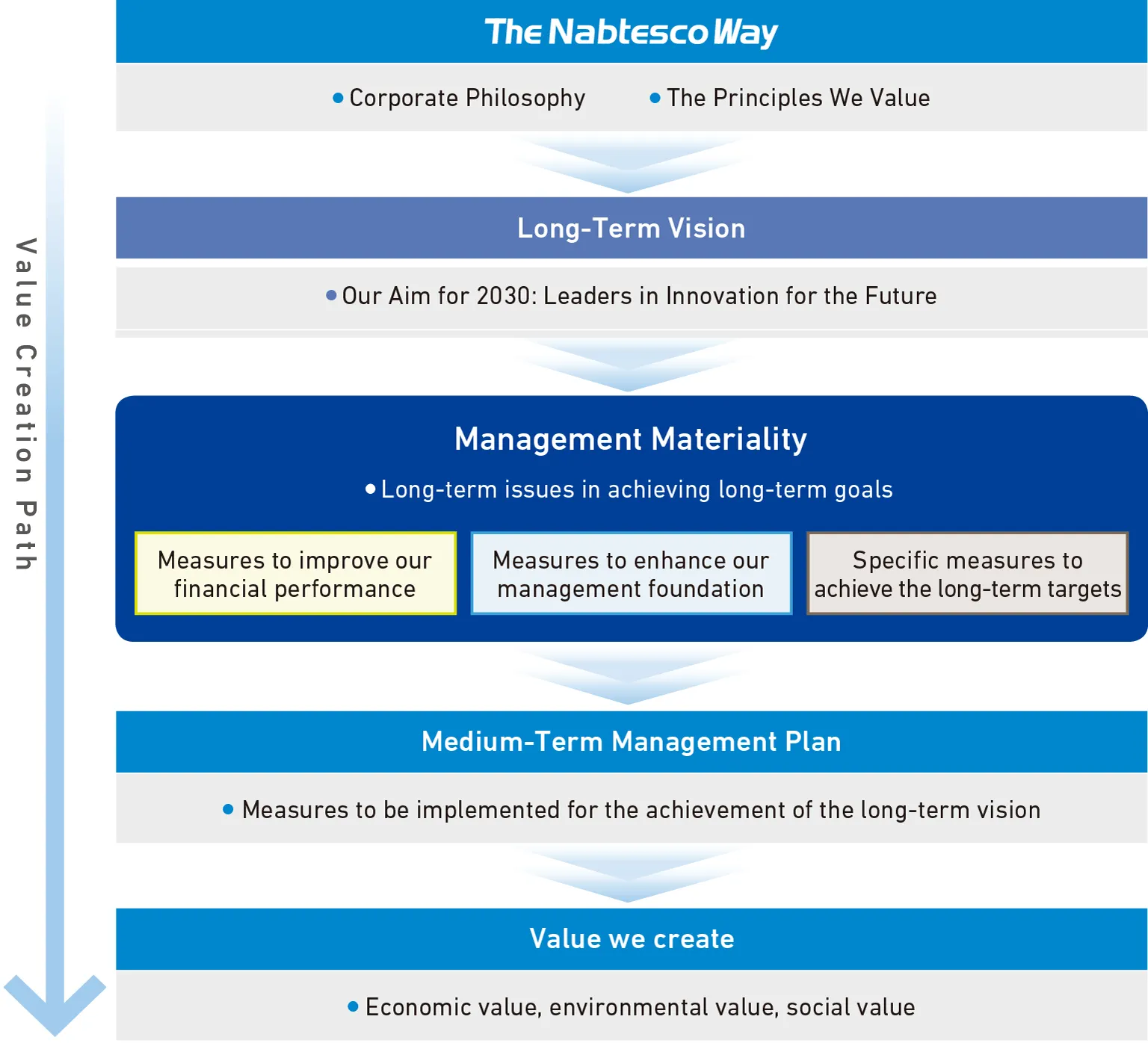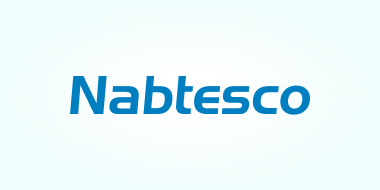
Value creation story and management materiality
Value creation story
Our Corporate Philosophy is to provide safety, comfort and a sense of security in people’s daily lives as well as across all forms of transportation with our unique motion control technologies. The Nabtesco Way is the statement of the stance and mindset that achieves this Corporate Philosophy, as The Principles We Value. Under this philosophy and the principles, we are promoting a long-term value creation story, consisting of the Long-term Vision that illustrates our aim for 2030, Management Materiality that presents the important challenges we need to work on to achieve our Long-term Goals, and the Medium-term Management Plan, which describes measures to achieve our Long-term Targets. Through these measures, we aim to bring innovation while improving economic value, environmental value and social value in the long-term, in pursuit of management that sustainably develops both society and our group.
Nabtesco’s value creation story

Management Materiality
Our Approach to Management Materiality
Our group positions management materiality as the most important management issue. To create long-term value, we are continuously and appropriately adjusting our management materiality in response to changes in the business and societal requirements. Accordingly, we strive to steadily take action on each item to further enhance our management foundation as we pursue the sustainable growth of both society and our group.
Structure of Our Management Materiality
Our management materiality is comprised of three pillars. By fostering financial and non-financial measures and striving to achieve economic value, environmental value and social value from long-term perspective, we will keep providing value to our stakeholders, maintaining profitable growth.
For “Measures to improve our financial performance,” we will work to consistently achieve our short-term revenue targets, ensure the efficient distribution of our managerial resources, and increase our capital efficiency for the promotion of ROIC-oriented management.
For “Measures to enhance our management foundation,” we have identified items that need reinforcement to more effectively contribute to society through our business activities. Consequently, we will implement intensive measures for activities related to ESG items, considering their connections to our profit and growth.
Moreover, by implementing “Specific measures to achieve the long-term goals,” we will strengthen our business activities, including social contributions, and thereby promote our long-term growth.
Our sustainability governance structure
To enhance our sustainability governance, our group dissolved our previous CSR Committee in 2023 to pave the way for its existence as the newly established CEO-directed Management Materiality Committee.
The committee collaborates with other CEO-directed committees, and the Management Materiality Committee Chair, who is an executive officer, supervise and oversees the setting of goals and KPIs for each management materiality item, along with their progress and management. The activities are deliberated and determined at the Management Committee and reported to the Board of Directors’ meeting to enhance the effectiveness of group-wide sustainability governance.
Structure to promote sustainability governance
Management Materiality Identification Process and Regular Reviewing
Our group identifies management materiality by extracting social issues addressed through our business strategy and ESG items closely related to our business, analyzing their significance from the perspectives of impact on our company and stakeholders. In terms of their validity, we engage in deliberations with external experts, conduct reviews within the Management Materiality Committee and the Management Committee, and finalize decisions at the Board of Directors’ meeting.
For management materiality, changes are made once a year to respond swiftly and appropriately to shifts in the business and societal requirements. Regardless of whether changes are made, the final decision is made once a year at the Board of Directors’ meeting.
Identification process
- #1 Recognition of issues
-
- Based on social challenges from those addressed through our Group’s business strategy and ESG items closely related to our business, the social challenges within the social and business environments surrounding our Group are extracted.
- #2 Analysis of significance
-
- Based on the concept of double materiality, the significance of issues or challenges is analyzed from the perspectives of “impact on the Company” and “impact on stakeholders,” with the results organized into keywords.
- #3 Identification of materiality
-
- Opinions are exchanged with external experts.
- Materiality is identified after obtaining approval from the Board of Directors, following discussions in the Management Materiality Committee and the Management Committee.
- #4 Goal setting and monitoring
-
- Goals and action plans are set based on the priority level of the management materiality item.
- The status of efforts on the goals and action plans are continually monitored.
- #5 Regular revision
-
- Changes are made once a year according to changes in the business and societal requirements, expectations from stakeholders, and changes in the business strategies of our Group.
In 2024, we re-evaluated the validity and significance of our recognition of issues and changed materiality items to incorporate the aspects of “Improve profitability and clarify innovation areas as required by the new Medium-Term Management Plan” and “Double materiality, a key societal requirement.”
[Measures to improve our financial performance]
Given that the new Medium-Term Management Plan further promotes optimization of portfolio balance and ROIC improvement, this item has been integrated into “Promote ROIC management"
[Measures to enhance our management foundation]
This has been reorganized from an ESG perspective into the following categories:
- E: “Countermeasures for climate change”
- S: “Promote human capital management” and “Pursue safety, comfort and a sense of security”
- G: “Enhance corporate governance” and “Build a resilient corporate foundation”
[Specific measures to achieve long-term targets]
To indicate the directions and strategies of the new medium-term management plan more clearly, this has been revised to the following: “Meet social challenges through smart motion control,” “Transform to innovative manufacturing with digitization ,” and “Enhance global management.”
In addition, for each management materiality item, sub-materiality and KPIs will be established to strengthen the progress management of various initiatives, thereby enhancing effectiveness.
Management Materiality Indicators and Targets
The targets, indicators, key activity results and plans for respective issues concerning “Enhancing our management foundation” with relation to the management materiality for FY2024 are shown below.
Targets, indicators and key activity results concerning sustainability
ESG items having a major impact on financial issues
| ESG Category |
Management Materiality items | Desirable Direction /Major Actions |
Targets for FY2024 (Extracts) |
Achievements in 2024 (Extracts) |
|---|---|---|---|---|
| Enviro- nment (E) |
Countermeasures for Climate Change |
|
|
|
| Society (S) |
Deliver Solutions for Social Challenges Through Business |
|
|
|
| Build a Resilient Supply Chain |
|
|
|
|
| Gover- nance (G) |
Increase the Effectiveness of Our Management Entities |
|
|
|
- *1Medium-term Management Plan
- *2The figures for CO2 emission reductions in FY2024 are based on the aggregated data available at the time of disclosure.
ESG items that drive sustainability power
| ESG Category |
Management Materiality items | Desirable Direction /Major Actions |
Targets for FY2024 (Extracts) |
Achievements in 2024 (Extracts) |
|---|---|---|---|---|
| Enviro- nment (E) |
Foster Environmental Management |
|
|
|
| Society (S) |
Pursue Safety, Comfort and a Sense of Security |
|
|
|
|
|
|||
| Enhance Human Capital Management |
|
|
|
|
| Promote Engagement with Local Community |
|
|
|
|
| Gover- nance (G) |
Ensure Management Transparency |
|
|
|
Targets, indicators and key activity plans concerning sustainability
Our Group has been reviewing its management materiality since FY2025. The latest activity goals are as follows:
| ESG Category |
Management Materiality items | Desirable Direction /Sub-Materiality |
Targets for FY2025 (Extracts) |
|---|---|---|---|
| Enviro- nment (E) |
Countermeasures for Climate Change |
|
|
| Society (S) |
Pursue Safety, Comfort and a Sense of Security |
|
|
| Enhance Human Capital Management |
|
|
|
| Gover- nance (G) |
Enhance corporate governance |
|
|
| Build a resilient corporate structure |
|
|



